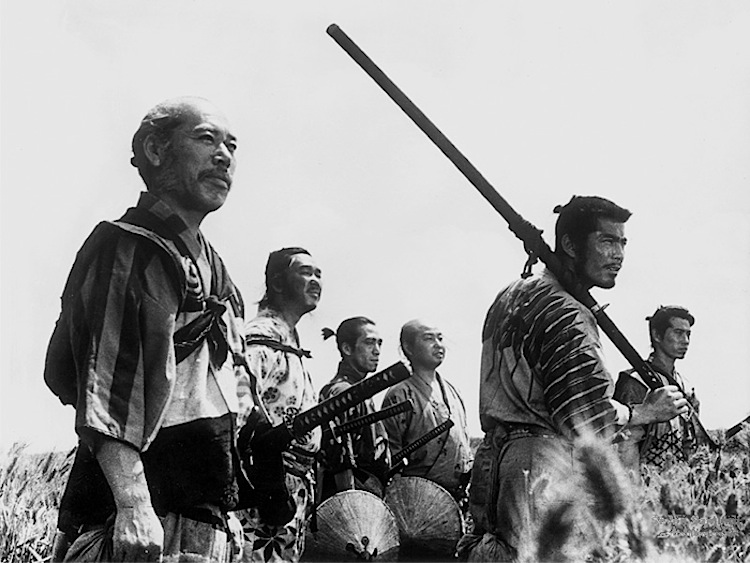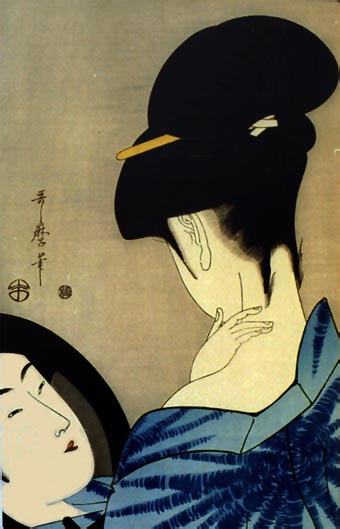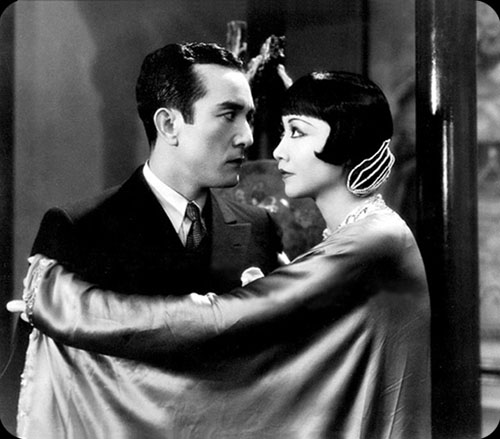
By Govindini Murty. As the Japanese reel from the triple blow of a massive earthquake, a terrible tsunami, and now a nuclear crisis, I wanted to ask Libertas readers to do anything they can to support Japanese relief efforts by donating here to the Red Cross.
Japan has one of the world’s great cultures – and more important than that, they are our friends and allies and they deserve our support. Jason and I had the opportunity to visit Japan some years ago, and we came away with a tremendous respect for the beauty and sophistication of Japanese culture – and for the courtesy, intelligence, and resiliency of the Japanese people. Whether we were walking down the Ginza in Tokyo, or hiking through the Japanese Alps, or visiting temples in Kyoto and Nara, we were touched on every occasion by the hospitality of the Japanese people – and by their extraordinary commitment to the aesthetic sense.

I remember on one occasion walking down the Ginza with Jason, taking in its modernist labyrinth of shiny skyscrapers and flashing electric signs. (Jason and I kept commenting to each other that we felt like we were in a scene from Blade Runner.) We stopped in one store that had a mysterious, old-fashioned air to it that set it apart from the rest of the hypermodern street. The store turned out to sell incense and other supplies for Buddhist temples. When we showed an interest in their wares, the owners kindly invited us to come upstairs and have a tour of their private museum. The most magical, hidden world was unveiled before our eyes. We were taken into a room paneled in black lacquer, and around its walls was arranged the most exquisite collection of golden, miniature Buddhist shrines. In the middle of the room was the most remarkable sight of all: a tea pavilion completely covered in gold leaf, a copy of the famous golden tea pavilion built for the medieval warlord Toyotomi Hideyoshi.
On another occasion, family friends invited us to dinner at the fabled Ichiriki teahouse in the Gion district of Kyoto. Several of Kyoto’s most famous and charming geisha entertained us with traditional Japanese songs, music, and dance. (Geisha are now important cultural ambassadors for the Japanese arts.) When our hosts heard that we were interested in Japanese history, they asked the mistress of Ichiriki to bring out some of the teahouse’s famous samurai artifacts. She brought out an ancient samurai helmet (we have some amusing photos of Jason and his father trying it on) and told us fascinating stories from the teahouse’s three hundred-year history – including those recounting Ichiriki’s role in one of Japan’s most famous samurai stories, Chushingura – The Tale of the 47 Loyal Ronin.
On yet another occasion, we had the opportunity to visit Nara, the ancient capital of Japan during the 8th century A.D.. An elderly volunteer docent spent several hours showing us around the temples and monuments of Nara, of which the most extraordinary is the Great Buddha of Todai-ji. We were touched by the tremendous pride this gentleman took in his heritage, and by the care and patience he took to explain it to us. I remember one particularly graceful wooden pagoda that this gentleman pointed out to us – the pagoda of Yakushi-ji – that had survived intact for over a millennia. Gazing up at it beatifically, he described its elegant lines and symmetry to us as “frozen music.”
The love that the Japanese people have for their cultural heritage and the ties that they feel to their beautiful land are sources of strength that will help them to recover from this latest disaster. But for all of their elegance and reserve, the Japanese are a sensitive people who, already shaken by a troubled economy and by domestic political crises in recent years, have been truly rocked by this latest tragedy. Japan needs all the friendship and support we can give it right now.

Any artist or creative person would wish to see Japan survive and thrive. After all, it was Japan that gave us such exquisite literary works as The Tale of Genji, The Pillowbook of Sei Shonagon, and The Tales of Ise, written by a remarkable group of women writers over a thousand years ago. The stunning wood-block prints of Hokusai, Hiroshige, and Utamaro have influenced Western artists from Monet, Van Gogh, and Toulouse-Lautrec on, and Japan’s enigmatic Kabuki and Noh theater has electrified Western avant-garde drama. And of course, such filmmakers as Akira Kurosawa, Yasujiro Ozu, Kenji Mizoguchi, and Kon Ichikawa have made their own indelible contributions to world cinema with movies like The Hidden Fortress, Tokyo Story, Ugetsu, and The Burmese Harp.
In particular, Japan’s talented film artists have formed one half of a vibrant East-West cultural exchange that has enriched both the American and the Asian cinema through its history. In the 1910s, Japanese-American star Sessue Hayakawa became a romantic idol in such Hollywood films as Cecil B. DeMille’s The Cheat. In the 1950s and ’60s, director Akira Kurosawa was inspired by the Westerns of John Ford to create such iconic samurai films as The Seven Samurai and Yojimbo (both starring one of my favorite actors, Toshiro Mifune). The process of cultural interchange continues today, with George Lucas incorporating aspects of Japanese culture into his Star Wars films, Sophia Coppola adopting minimalist Japanese screen grammar in her Lost in Translation, and Japanese directors like Hayao Miyazaki reshaping traditional Western animation into the vibrant, kaleidoscopic world of anime.
This cultural interchange is all the more remarkable given that just two generations ago, America was locked in a brutal war with Japan. That America is close allies today with a free Japan – a country that many said would never become a democracy – shows that we must always hold open the prospect of liberty to a people, so that those who were once the worst of enemies can one day become the best of friends. This is a crucial point to remember as we encourage the Muslim pro-democracy revolutionaries in the Middle East, for they are showing us every day that no people should be written off when their freedom is at stake.
However, a vibrant intellectual and artistic culture is a crucial prerequisite for the lasting triumph of freedom and democracy. The richness of Japanese culture has given it the spiritual strength to survive one calamity after another in the modern age. We pray that like the brave, resilient villagers of The Seven Samurai, Japan will eventually recover from this horrendous crisis.
Posted on March 16th, 2011 at 8:44pm.
A beautiful article Govindini and one that is so helpful at a time like this.
That is a very elegant piece, Govindini. It’s informative and sticks to the Libertas narrative — well done.
For lovers of Japanese cinema, it is worth noting on March 26th the Viz New People Cinema will hold a special benefit screening of HULA GIRLS, which is set in Fukushima. Also, here in New York, the Japan Society will be donating 50% of film tickets to relief efforts. That includes the Yakuza retro that concludes this weekend with several American premieres.
http://www.newpeopleworld.com/films/films-3-2011/#tsunami_relief
http://www.japansociety.org/hardest_men_in_town
Thanks so much everyone for your comments. Japan needs everyone’s support right now.
Special thank you also to J.B. for pointing out the Japan fundraisers – I will update my post with those new links when I have a moment. Libertas has been down periodically because of the huge traffic we are getting from our “Red Dawn” exclusive, so many thanks for everyone’s patience.
I would add that Japan has more recently given the world Hirokazu Koreeda, whom I regard as Ozu’s spiritual heir and as the greatest living film director.
Let me quote, in honor of Japan’s great cultural tradition, Yeats’ poem “My Sword”:
Two heavy trestles, and a board
Where Sato’s gift, a changeless sword,
By pen and paper lies,
That it may moralise
My days out of their aimlessness.
A bit of an embroidered dress
Covers its wooden sheath.
Chaucer had not drawn breath
When it was forged. In Sato’s house,
Curved like new moon, moon-luminous,
It lay five hundred years.
Yet if no change appears
No moon; only an aching heart
Conceives a changeless work of art.
Our learned men have urged
That when and where ’twas forged
A marvellous accomplishment,
In painting or in pottery, went
From father unto son
And through the centuries ran
And seemed unchanging like the sword.
Soul’s beauty being most adored,
Men and their business took
The soul’s unchanging look;
For the most rich inheritor,
Knowing that none could pass Heaven’s door
That loved inferior art,
Had such an aching heart
That he, although a country’s talk
For silken clothes and stately walk,
Had waking wits; it seemed
Juno’s peacock screamed.
David – thank you for the Yeats poem and your comments on Koreeda. I have yet to see Koreeda’s “Maborosi,” but I know you hold it in high esteem and I will have to add it to my list of films to watch. As for Yeats, it has always fascinated me that Japanese culture influenced to a remarkable degree so many of our great modernist poets and artists in the early twentieth century.
My mental slip! The poem is not “My Sword” but “My Table.”